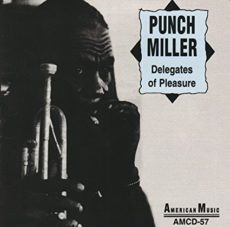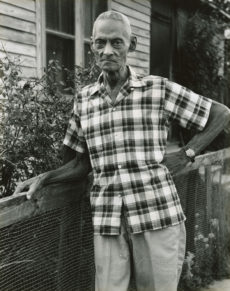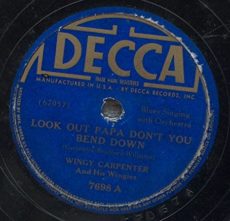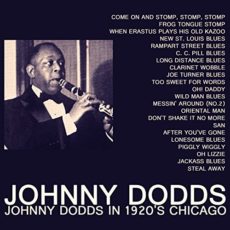
Daily Dose Of Jazz…
Punch Miller was born Ernest Miller on June 10, 1894 in Raceland, Louisiana and learned to play the trumpet as a child. He was also known as Kid Punch Miller in New Orleans, Louisiana, where he was based from 1919 to 1927,
He moved to Chicago, Illinois and worked with various bands, including Jelly Roll Morton and Tiny Parham, as well as appearing on a number of recordings. His lifestyle and the decline of Dixieland or New Orleans jazz led to his return to mostly doing festivals and falling out of the limelight. This changed with the rising importance of the Preservation Hall Jazz Band and he returned to national attention.
He returned to New Orleans, playing at Preservation Hall and leading a band under his own name, in addition to playing with other groups. In 1963 he toured Japan with the clarinetist George Lewis.
Trumpeter Punch Miller, who was the subject of the television documentary Til the Butcher Cuts Him Down, passed away on December 2, 1971 in New Orleans.
#preserving genius
More Posts: trumpet

Daily Dose Of Jazz…
Lawrence Duhé was born April 30, 1887 in La Place, Louisiana. He played with Kid Ory in his youth, and followed Ory to New Orleans, Louisiana. There he played clarinet with Ory, King Oliver, Frankie Duson, and led his own band in Storyville.
Duhé moved to Chicago, Illinois in 1917 and his band became popular in the clubs and dance halls. They played in the stands at the notorious 1919 World Series. During the Roaring Twenties he led Sugar Johnnie’s New Orleans Creole Orchestra comprised of Lil Hardin, Sidney Bechet, King Oliver, Freddie Keppard, tubby Hall and Mutt Carey among others.
By the mid-1920s he had returned to New Orleans and for a time played with Armand J. Piron. After touring with the Rabbit Foot Minstrel Show, Lawrence worked out of Lafayette and New Iberia in Southwest Louisiana with such musicians as Evan Thomas and Bunk Johnson before retiring from music in the 1940s.
Clarinetist and bandleader Lawrence Duhé, passed away in Lafayette, Louisiana in 1960.
Sponsored By
www.whatissuitetabu.com
![]()
#preserving genius
More Posts: clarinet

Daily Dose Of Jazz…
Johnny St. Cyr was born on April 17, 1890 in New Orleans, Louisiana. St. He led several bands in the Crescent City beginning around 1905 and performed on the riverboats with Fate Marable. He played for several leading New Orleans bands including A.J. Piron, the Superior, Olympia and Tuxedo bands before moving to Chicago, Illinois in 1923 with King Oliver.
He is most commonly remembered as a member of Louis Armstrong’s Hot Five and Hot Seven bands. He also played and recorded with Jelly Roll Morton’s Red Hot Peppers. St. Cyr also performed with Don Cook’s Dreamland Orchestra. He composed the popular standard Oriental Strut, noted for its adventurous chord sequence.
In 1930 Johnny returned to New Orleans to make a living as a plasterer while still playing with local bands led by Paul Barbarin or Alphonse Picou. In 1955 he moved to Los Angeles, California and returned to music full time. From 1961 until his death in 1966, he was the bandleader of the Young Men from New Orleans that featured Barney Bigard, performers at Disneyland.
Banjoist and guitarist Johnny St. Cyr passed away on June 17, 1966 in Los Angeles, California.
Sponsored By

Voices From The Community
![]()
#preserving genius

Daily Dose Of Jazz…
Theodore “Wingie” Carpenter was born on April 15, 1898 in St. Louis, Missouri. He lost his left arm as the result of an accident during his early teens, with the amputation performed by a noted surgeon who was an uncle of jazz musician Doc Cheatham. Sometime later, he took up the trumpet and by 1920 he was working in traveling carnival shows, and in 1921 he toured with Herbert’s Minstrel Band.
By 1926 he had settled in Cincinnati, Ohio and worked with Wes Helvey, Clarence Paige, Zack Whyte, and Speed Webb. In 1927, Wingie played in Buffalo, New York, with Eugene Primus. Off and on from late 1926 through 1928, he was featured on the Whitman Sisters’ Show with pianist Troy Snapp’s band.
During the early 1930s the trumpeter was featured with Smiling Boy Steward’s Celery City Serenaders and another Florida band led by Bill Lacey. In the mid-1930s, he became a touring regular with bandleaders including Jack Ellis, Dick Bunch, and Jesse Stone. By the late 1930s, Carpenter settled in New York City, where he worked with Skeets Tolbert and Fitz Weston.
From 1939 on, Wingie worked as the leader of his own band through the 1960s, playing occasional dance dates and working for periods at well-known clubs such as The Black Cat, The New Capitol, Tony Pastor’s The Yeah Man, and other venues. He composed several works not limited to Look Out Papa Don’t You Bend Down, Preachin’ Trumpet Blues, Put Me Back In The Alley, Rhythm of The Dishes and Pans, and Team Up.
Trumpeter, vocalist and bandleader Wingie Carpenter, who was one of several one-armed trumpeters who worked in the music business, including similarly nicknamed Wingy Manone, passed away on July 21, 1975 in New York City.
Sponsored By
![]()
#preserving genius

Daily Dose Of Jazz…
George “Little Mitch” Mitchell was born March 8, 1899 in Louisville, Kentucky and took up the cornet at the age of 12, joining a local brass band in Louisville. From 1921-3 he recorded with Johnny Dunn’s Original Jazz Hounds and Johnny Dunn’s Original Jazz Band on the Columbia label.
In 1926 Little Mitch recorded with the New Orleans Wanderers and New Orleans Bootblacks, taking the place of the unavailable Louis Armstrong. Shortly afterwards he recorded with Jelly Roll Morton’s Red Hot Peppers. He also went to record with Luis Russell, Johnny Dodds and The Earl Hines Orchestra.
Cornetist George Mitchell ended his active but short career on the 1920s jazz scene around 1931, never leading a recording session, opting to become a bank messenger. He passed away on May 22, 1972 in Chicago, Illinois.
Sponsored By

![]()
#preserving genius
More Posts: cornet



